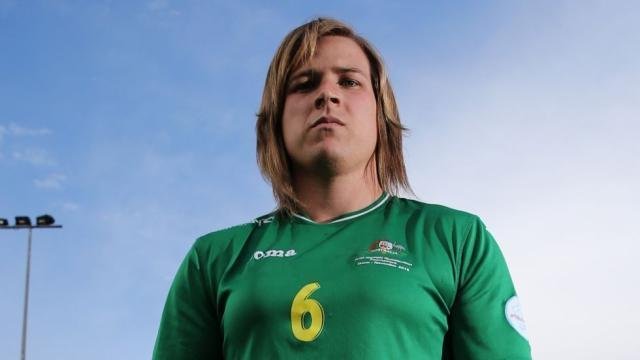
The decision by the Australian Football League (AFL) to refuse to allow transgender woman Hannah Mouncey to nominate for the Australian Football League Women (AFLW) draft has drawn widespread criticism as a reflection of the AFL’s lack of real commitment to inclusion.
While it is important that the AFL's decision is criticised and we should highlight the troubling logic of policing “womanhood”, it is also important that we look critically at the role played by anti-discrimination legislation in the AFL’s decision and how it highlights the broader weaknesses of this legislation when it comes to protecting the rights of trans and non-binary people, particularly trans women.
The AFL’s position had been “in development” since June when Mouncey was first approached by AFLW clubs to consider nominating for the draft. On October 17 the AFL made its position clear: Mouncey could not nominate on the basis “of analysis of transgender strength, stamina and physique, as well as the AFLW being in its infancy”. Based on this, the subcommittee believed Mouncey would have had “an unreasonable physical advantage over her opponents”.
The timing of the announcement, the evening prior to the draft, has been seen as deeply cynical as it prevented any action to challenge the legality of the decision.
While the AFL’s decision was supposedly based on an analysis of “transgender strength, stamina, and physique”, it is premised on erroneous assumptions about how men and women differ in general in these characteristics with a primary focus on Mouncey's height and weight — she is 190 centimetres’ tall and weighs 100 kilograms.
In asserting that Mouncey would have an advantage over other players, they ignore the diversity of physiques within humanity and assume that Mouncey’s size falls outside the realms of what a woman athlete could be. This is clearly not true, as, if Mouncey had been drafted, she would have been taller than the vast majority of players, but she would not have been the tallest player in the AFLW. That honor goes to 194 centimentres’ tall Erin Hoare, who is also a goal shooter with the New South Wales Swifts in the Super Netball competition.
As Mouncey's coach Chris Rourke pointed out, the arguments against her being eligible to play are based on assumptions that Mouncey is a physical threat to other players. This ignores the fact that women, such as 2016 Olympic shot put gold medalist Michelle Carter, who is 175 centremetres’ tall and weighs 118 kilograms, can be physically larger than Mouncey.
The AFL’s exclusion of Mouncey is an effort to police the boundaries of womanhood. It is not just bad for trans women, but for any woman who is substantially taller or more muscular than the “average”. Champion tennis players Serena and Venus Williams are regularly subjected to racist and transphobic slurs by fans and officials. The most infamous transphobic comments were from Russian tennis official Shamil Tarpischev.
While the concern over size in the ALFW has been premised on concern over player safety, as Richard Hinds pointed out on the ABC, no such concern is expressed over the size disparities in the AFL between 211 centimetres’ tall Aaron Sandilands and 173 centimetres’ tall Lewis Taylor or that Mouncey has been and will continue to play in a lower level women’s competition.
Some commentators have raised concerns that the AFL has failed to apply the International Olympic Committee’s rules regarding the participation of trans women in women’s sport. Under this rule, which Mouncey meets, a trans woman must undergo hormone therapy and demonstrate that the total level of testosterone in the blood has been below 10 nanomols per litre for at least a year before competing.
However, while the IOC rule is clearly better for trans women athletes than the approach adopted by the AFL, there are real problems with this rule. Limits on the level of testosterone for a woman to be able to compete are arbitrary and have been used to exclude women athletes such as South African middle distance runner Caster Semenya and Indian sprinter Dutee Chand. This exclusion was overturned when the Court of Arbitration in Sport suspended the International Association of Athletics Federation’s rule on the basis that it had failed to prove that women with naturally high levels of testosterone had a competitive edge.
While the AFL’s decision to exclude Mouncey from the draft is discriminatory, it is arguably consistent with the exemptions within the Human Rights and Equal Opportunity Act (Vic), which the AFL relied on in reaching its decision. The law allows lawful discrimination against a person on the basis of their sex or gender identity if strength, stamina or physique is relevant. While this does not mean sporting organisations must discriminate against trans athletes, it means that they can, although the basis for doing so can be contested legally.
This reflects the reality that the law, which is supposed to provide protection from discrimination, enables transphobia in sport and other aspects of social life. Avoidance of discrimination is based on organisations going beyond the requirements of the law rather than complying with it. This reality is not limited to the Victorian law, but is a feature of aspects of anti-discrimination legislation in other Australian jurisdictions.
While we must call on the AFL to reverse its transphobic approach in excluding trans women from the AFLW, we should also call for state and federal governments to provide greater protection from transphobic discrimination in anti-discrimination legislation.
[Lisbeth Latham is a trans woman and a member of the Socialist Alliance.]
Like the article? Subscribe to Green Left now! You can also like us on Facebook and follow us on Twitter.